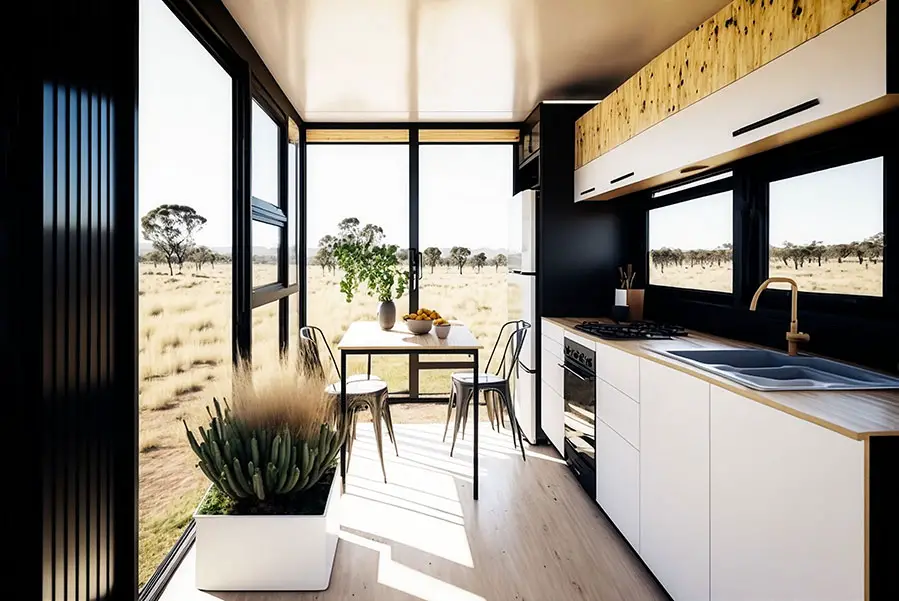Tiny Home Harmony: A Feng Shui Guide
Feng Shui for tiny homes can drastically improve your emotional and physical wellbeing. Living in a tight space can often be stressful, especially when things go wrong such as utility damage or torrential rain. Building an interior that speaks to the soul will improve your tiny home experience.
In the rest of this article, I’ll go through the details of tiny homes and the types of tiny houses you can build or buy. We’ll talk about financial considerations as well as the Feng Shui concerns you need to take into account to live the best life possible in your tiny home.
What Are Tiny Homes?
The drive toward simple living is becoming much more prevalent in today’s world. Some communities are choosing to live in smaller spaces to offset their carbon footprint with many people embracing the ability to live with restraint and in tandem with nature. The other side of the Tiny Home movement comes down to affordability. With standard house and land prices either being beyond many people, or the idea of trading your working future to make bankers wealthier, tiny homes have simply become a better alternative.
Tiny homes are small homes, usually under 400 square feet (37 square meters), that are often found in communities in natural areas such as woodlands and mountains. Many of these tiny houses are located off the grid and combine natural living with modesty and moderation. Trucks, old school buses and delivery vehicles are becoming more popular as versions of tiny homes too.
You can choose to purchase a tiny house or even build one yourself from scratch. Many people choose to use old shipping containers or recycled minivans to create their tiny homes, allowing them to move from place to place quickly.
Embracing this way of living can be difficult at times, and you’ll need to completely declutter your life and only bring along the essentials. These tiny dwellings can come in many different shapes, and there are countless ways to make the space your own.

There are a few reasons people may choose to live in a tiny home. For starters, financial considerations are often the primary reason, considering rent and utility prices that are rising every year. It is much easier to purchase a tiny home, and you may not even need a mortgage. You’ll usually pay under US$40,000 for the average tiny house, making it easier to budget than a traditional home.
These homes have met a lot of hype on television, with tiny home communities becoming center stage for those interested in living more simply. Alternative methods of living are ever more popular now, given the current global economy. Additionally, it takes a certain skill level to design and build a space-efficient enough to allow for long-term living.
The materials usually used to build a tiny home are recycled and sustainable, bringing even more meaning to the tiny home life. Existing in tandem with nature is one of the most vital aspects of living in a tiny house. The cozy character of the dwellings is often inspired by Japanese or Scandinavian designs, enhancing peace and harmony within the home.
Here are some of the advantages of living in a tiny home:
- Ability to move around freely.
- Financial independence.
- Environmentally-conscious living.
However, there are a few disadvantages to living in such a tight space:
- Not much room to move around.
- You won’t be able to keep as many of your personal belongings.
- You may have trouble hooking up essential utilities.
- Lack of space for visitors.
Are Tiny Homes Really Cheaper?
Although financial considerations are often the first thing that comes to mind when thinking about living in a tiny home, there are a few caveats. Although life is cheaper on a small scale, it often means paying more for basic necessities if you choose to live independently rather than within a community setting.
Tiny homes are cheaper than traditional ones, being 87% less expensive than the average home. However, you may find that the price per square meter increases in a tiny house, and there might be higher up-front expenses relating to utilities and other essential amenities.
You can buy a tiny home for a lower price than a traditional home, but preparing to live in one might be more expensive in the short term. For example, if you don’t have access to water, you may need to dig a well near the property. If you don’t have experience in building and construction, you may need to pay someone to do this for you.
Additionally, solar panels (if you choose to go off-grid completely) are expensive to install. However, they’ll save you money in the long run, so the relatively high up-front costs are subsidized down the line.
Many of these costs will depend on a few things:
- The way you choose to live.
- Where your tiny home is located.
- The amenities and utilities you already have access to.
The materials you choose to build your tiny home will be a factor in this, and you may also have to buy a permit to build it in the first place (depending on the structure of the property and its location).
If you’re looking for luxury, it’s safe to say that you can easily spend more than intended on your tiny home. Complex interior design options can often rack up a pretty hefty bill – especially if you’re paying a company to do the work for you.
Proper planning will aid you in keeping your costs down, and moving into a tiny home doesn’t have to be expensive. However, your location will be a significant determinant of how much you spend.
Practical Considerations
If the idea of living in a tiny house inspires you to live more simply, you’ll need to think about a few practical considerations. These will enable you to plan effectively and keep costs to a minimum. If you know exactly what you want, you’re more likely to build (or buy) the best tiny home for you.
Building Experience
You don’t need building experience to have a tiny home – you can buy and repurpose one, or you can easily pay a company to do the construction work for you. However, if you’re looking for specific details in your home without bringing in a construction crew, you may have to consider doing some of the work yourself.
While a tiny home may not seem too complicated to build, it is more complex than you think. It requires significant effort and planning to create designs that make the most out of a small space.
If you’re planning to build your own tiny home and don’t have any experience with construction, you may need to practice beforehand. Try your hand at a few small projects to get familiar with the essential tools and materials. It may take a bit of trial and error at first, but if you can recruit friends and family to help you and plan accordingly, you can succeed.
Kits vs. DIY
Choosing to build your tiny home yourself is always easier with a registered company’s pre-planned toolkit. You’ll find blueprints much easier to work with if they’ve been created by a professional, and it will often speed up the process.
If you want to do it yourself in its entirety, you can do so if you have practical building experience.
Used Containers and Vehicles
You may find that many tiny homes are made from traditional brick and mortar materials. However, a growing number of tiny homeowners have utilized recycled shipping containers and repurposed mini buses and vans. If you’re environmentally conscious, doing this is an excellent way to keep your carbon footprint low.
Using an old shipping container is an excellent way to go. There are some advantages since they can be easily transported and provide home security due to their material.
However, there are a few disadvantages to using a shipping container that you should be aware of:
- If you want to cut out windows, the price will go up since you will need a construction crew to do this for you.
- They’re not very wide and are only suitable for those who don’t mind living in very tight spaces.
- They have no heating or cooling capacity, so if you live in an area with extreme weather, you’ll either have to spend more on utilities or choose another option.
Alternatively, if you buy an old van, you can easily turn this into a tiny home. These mobile houses can be easily hooked up to utilities, and they’re relocatable! In other words, you can move them around from place to place without too much hassle.
If you already have a car or a van, you also have the option to buy a camper shell. You can attach it to the back of your vehicle and make moving around much more manageable. This is an excellent option if freedom of movement is particularly important for you and your family.
Utilities
You’ll inevitably need to consider how you’re going to power your tiny home. Heating and cooling options abound and will depend on the property’s location. An adequate water system is critical if you’re living off-grid.
One of the best options for water supply if you’re living in nature is to use filtered rainwater. Doing this means you only bear the cost of a water filter, and if your area experiences a fair amount of rain, you’ll likely never run out of water.
In terms of fuel, you can purchase propane tanks to keep your carbon footprint low. If using clean energy is important to you, considering these options is essential.
Many tiny homes are hooked up to a double plumbing system, which allows them to use filtering systems alongside the more traditional pump and tank system that traditional houses use.
In terms of electricity, living in a tiny home community or village is helpful since you will be able to share pooled resources and power lines. We’ll go into more detail about tiny home villages below.
What About Tiny Home Villages and Communities?
An excellent option for living a tiny life is to join an already-established village or community.
Tiny home villages and communities provide support for people living in the area and often share their resources. Joining one may not give you much freedom of movement, but these villages are usually located in natural, beautiful spaces like mountainous regions and woodlands.
Pros of Tiny Home Communities
- They allow you to live in tiny home societies that offer year-round support and friendship.
- It may mean you have access to public amenities in the area, such as swimming pools, retreats, group gatherings, spas, and other things that will make your life more enjoyable.
- You can share resources with other community members, keeping overall costs down for everyone. This might include a consistent internet connection and access to electricity.
Cons of Tiny Home Communities
- There may be a distinct lack of privacy if you live in a tiny home village, especially if the space is relatively small.
- Small places can make problems seem more significant – if you have an issue with a neighbor, it might seem more problematic.
There are a few tiny home communities to consider. One example is the Community First! Village in Texas. They are a relatively large village that includes vehicles, small brick and mortar homes, and canvas houses for permanent living. Many of their inhabitants are disabled or previously had nowhere else to go.
Another excellent option to consider is the Lake Walk Community, based in South Carolina. They take community living to the next level, and the site boasts a communal fire pit, a rec center, and beautiful natural views of the surrounding mountains.
Whether or not you live in a tiny home community, it’s an excellent option to consider if you’re not willing to go it alone. They can offer invaluable support that you won’t have access to if you decide to go off the grid without a community that can give you a hand when you need it.
What Is the Feng Shui Front Door Direction for Converted Vans and Skoolies?
This is a difficult question to answer, since there can be so many different configurations. A Skoolie has a main door built in, but a converted Fedex van can have the entry through the drivers cabin or through the rear. Which ever door you mainly use to enter and exit should be counted as your front door, from there it is all about choosing a good spot to park for the night.
The entry to your living space sets the overall tone of your stay in any location, so start by checking that the direction opposite the door has a larger/higher land formation (like a building or hill) to provide support. From there, make sure that your door has a good view of lower land or open space.
You can then use different Feng Shui methods such as Ming Gua’s to work out the exact direction you’d like your door to face.
Like this article? Tap to share
List of Feng Shui Considerations
Understanding the basics of Feng Shui is essential to achieving a balanced home. Originating in the spiritual elements of Buddhism, it purports that even the most subtle changes can represent significant portions of your life.
The basics prevent you from living a chaotic life (which is crucial if you’re living in such a small space) and allow you the freedom to invite good energy into your tiny home. Just as utilities should form the basis of your practical considerations, they will be very important to your Feng Shui as well.
No matter which style of Feng Shui you use, the toilet, shower, cooker will all be important. Advanced schools such as SYYG also take into account the electrical and water systems of any built structure as well.
It can be helpful to take the Bagua map into consideration when attempting to achieve this balanced energy. This will bring an overall sense of calm, allowing you to fully relax in your tiny home. The basic 5 essential components of Feng Shui, to be taken into account when designing your home:
- Water: Water represents expression, clean living, and the flow of life. It allows your mind to remain clear and focused.
- Wood: This concept is tied to personal growth. It allows you to harness inner talents.
- Fire: Fire means that your life will be filled with passion and emotion.
- Earth: This component comprises the concept of stability, enabling you to remain grounded and at peace.
- Metal: This element gives you good health, helping you become prosperous as you grow.
These components will allow your home to emanate positive Chi and spiritual goodness. Taking each one into account in the layout of your home is the best way to achieve this.
I’ll go into some detail about different aspects of your home below, giving you a better idea of how to bring feng shui into your home.
Front Door
Placing your front door in the correct place is essential to achieving good feng shui. One of the critical aspects includes welcoming good energy into your house and opening out to possibilities and opportunities.
Your entryway will need to be completely clear. Allowing the space to be clear of mess and clutter is vital to give space to the good qi that will arrive through your front door. Make it look warm and inviting for the best results.
Stove
You might not have thought that the placement of your stove could have much of an impact on your home’s overall energy. However, the stove is one of the primary aspects of the kitchen, and the kitchen itself is the central hub of the house.
Your stove should never be placed directly opposite the main door to the house. It should be set slightly away from your sink to allow for adequate separation of the elements.
Water Storage
Where you place your water tanks, especially if you’re living in a tiny home, is paramount to the energy that comes into your house. Water tanks represent medicine jars, which allow illness to penetrate. Keeping your water tanks out of view of the front door and all windows will prevent this energy from impacting you and your family.
You can keep your water tanks to the side of the house (or under), where you can’t see them from the windows. Make sure they’re adequately covered to ensure protection from the elements.
Toilet and Shower
If you don’t have much space in your bathroom, the most vital thing to consider is minimizing your water consumption. This doesn’t have much to do with Feng Shui, but remaining at peace with nature means using its resources carefully and deliberately, trying not to waste anything.
Many tiny homes have very limited spaces for the bathroom, some combining the shower and toilet into one closet sized area. The most important thing in these cases is the relationship between the taps & drains to the center of the home and if they are at the correct angle.
If you have a larger space and, therefore, more freedom, you can include plants and flowers in your space. Additionally, keep the door shut to maintain modesty (and keep in odors).
Bed
Your bed is likely the most consistent aspect of your tiny home. Keeping your bed away from the direct focus of the bedroom door is a key component of Feng Shui since this allows poor energy to infiltrate your sleep.
Never place the bed above beneath electrical wiring or water pipes since this creates “pressure” within the space. Similarly, avoid placing the bed above motors or generators, as they can create a large magnetic field.
Stairs
The correct placement of your staircase is crucial since it should be in a place where energy can easily and freely shift throughout the house. Having your staircase directly in front of your entrance can pose problems, so try to have it placed on one side of the home.
Additionally, staircases are often made of one of the crucial components of Feng Shui: wood. Utilizing the position of the stairs to infiltrate creativity throughout your home will allow you to harness your inner spirit in a positive manner.
In an ideal world, your stairs should share a space with the exterior of your home. Avoid spiral staircases and stick with straight or curved designs that allow freedom of movement.
Where Can I Find Tiny Home Blueprints and Floor Plans?
You can find tiny home blueprints and floor plans online. Alternatively, you may be able to find customizable plans created by a local architect, allowing you more freedom to design your space more efficiently.
Tiny House Plans offer worksheets with blueprints and floor plans (some of which can be customized) for a small fee. These are an excellent resource for anyone considering a tiny home conversion because they allow you the flexibility to create your own home based on your needs.
Additionally, you will need an adequate checklist to formulate a decent plan for building your tiny home. The Tiny Life offers this checklist and other helpful information to create the perfect space for you.
Final Thoughts on Tiny Homes and Feng Shui
Feng Shui for tiny homes works in the same way as traditional homes. Being mindful of your space is essential when living in tight quarters, so Feng Shui can help you realign your belongings and design your home to give you peace of mind. For more information, contact Dean French for Feng Shui services.
Living in a tiny home sounds like something out of a fairytale, and in some ways, it is – but you’ll need to consider the complexities of living off the grid and building your space with limited resources in mind.
Feng Shui Resources
Learn the Ancient Chinese Arts of Feng Shui, Lunar Chinese Astrology, and Solar Chinese Astrology with Dean’s Comprehensive Bundle!
Get everything you need to start learning these ancient arts in one convenient bundle. This bundle includes detailed course notes and examples covering everything from the basics of Feng Shui to the more advanced concepts of Lunar Chinese Astrology and Solar Chinese Astrology.
They are clear, concise, and easy to follow, especially for beginners. You’ll learn everything you need to know to improve your life with the help of these ancient arts.
Limited time offer: Get a $150 bundle discount ($747 down to $597) when you purchase all three courses today!






